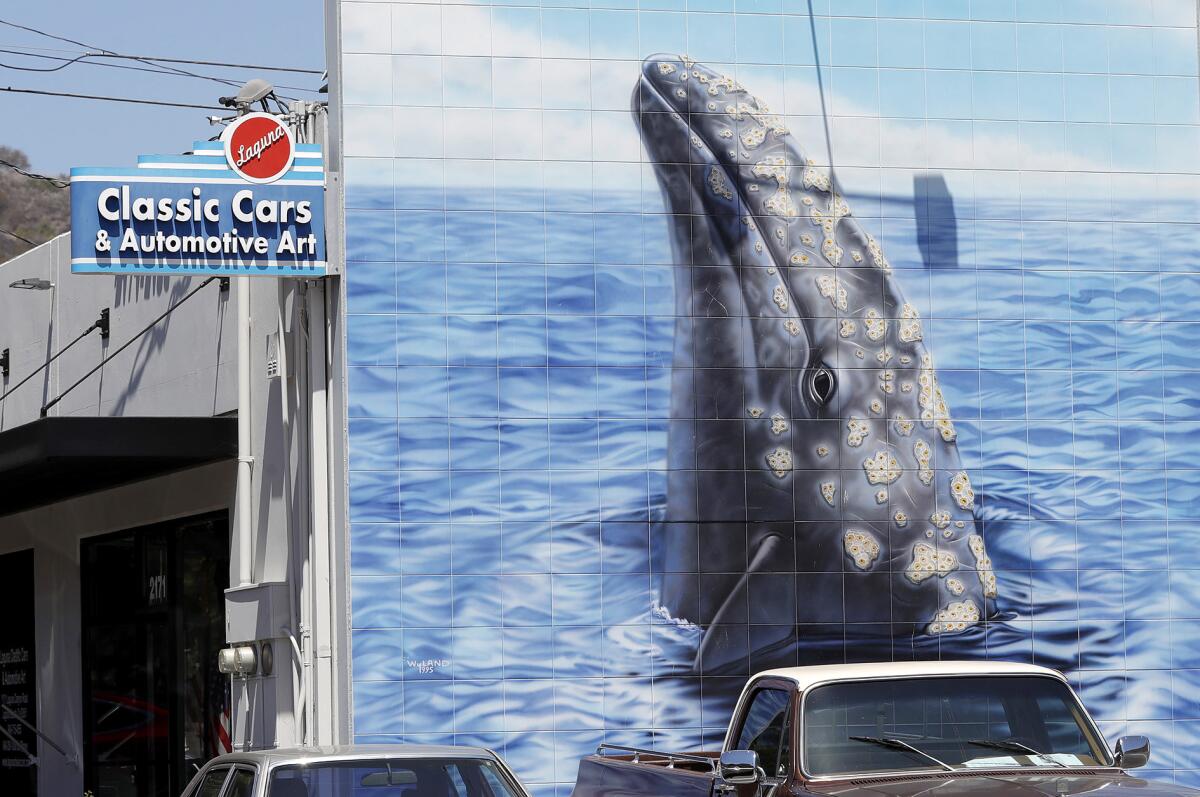Future of gray whale mural in Laguna Canyon yet to be decided

- Share via
Competing interests have left an uncertain future for a longstanding marine life mural in the Laguna Canyon.
For more than 30 years, a mural of a gray whale emerging from the water has greeted those that pass the property at 2171 Laguna Canyon Road.
Laguna Beach artist Robert Wyland, who was once a tenant in that space for his studio, originally painted the piece, and then a 450-square-foot ceramic tile version went through the city’s permitting process in 1995 and was introduced to the building the next year.
On July 30, members of the Wyland Foundation and supporters of Wyland’s work returned to the premises to hold an event to call attention to an effort to save the mural, which was first seen at the property in February 1987.
Steve Creech, president of the Wyland Foundation, said that the group of demonstrators consisting of about 20 people that showed up in person, were acting on an anonymous tip that the mural was going to be demolished.
The visual of the gray whale breaching the surface is considered one in a series of 100 “whaling walls” around the world that were created by Wyland between 1981 and 2008.
“When he started this project, there was nothing like it in the world,” Creech said. “Nobody had done anything of that scale, especially devoted to the conservation and protection of marine mammals, so this is an incredibly significant public arts project.”

The ceramic tile mural stands along the south wall of Laguna Classic Cars. The Dornin Investment Group, which owns the multi-tenant light industrial property, sought to make improvements to the space and received design review board approval on Feb. 13, 2020.
Included in those improvements was a plan to replace the existing mural with a directory sign that could display the names of current tenants of the building.
“We’d like to use that billboard sign for something other than a tenant that does not occupy space there anymore,” Chris Dornin, the CEO of the Dornin Investment Group, said.
Dornin disputed the notion that there was a plan in place to demolish the mural, but he added that Wyland has had ample opportunity to come and reclaim the mural.
He said communications were exchanged between the parties concerned as early as two years ago.
Wyland has concerns that the mural would not survive if it were to be relocated.
“Thousands, if not millions, of people have enjoyed that mural for over 30 years,” Wyland said in a prepared statement.
“Someone that buys a building shouldn’t be allowed to simply destroy art that has become part of the community. We think that’s something worth fighting for. It’s why there are now laws to protect public art.
“The mural has become too fragile to remove without suffering irreparable damage. We think it needs to stay right where it is, where it can inspire people and share the city’s commitment to art and our environment.”
Dornin said that in addition to offering for Wyland to come and take back the mural, offers have also been made to donate it to art colleges, and there have also been active discussions about donating the work to a couple of municipalities.
“There are municipalities that would be happy to take it and put it up in public spaces,” Dornin said. “Wyland’s got his own properties. He should go put it up on his own property, pull a billboard sign permit for his own property [and] put it up there.”
The Wyland Foundation focuses on the issues of clean water and a healthy ocean. Creech said he believes that the gray whale mural is symbolic of that cause and the community’s commitment to it.
The Visual Artists Rights Act of 1990 is one avenue being explored in the effort to preserve the mural, Creech said.
“It’s hard to see history while it’s being made,” Creech said. “You see it in retrospect, but now we’re starting to get a glimpse, looking back at Wyland’s artwork and the murals that he created. That’s a huge achievement.”
All the latest on Orange County from Orange County.
Get our free TimesOC newsletter.
You may occasionally receive promotional content from the Daily Pilot.




